Trends: Love and Marriage across Regions
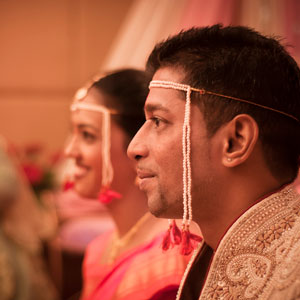
The cultural remix happening in India is unprecedented. All over the country inter-caste and inter-state marriages are forcing Indians into closer and more meaningful relationships, creating a colorful ethos based not on physical or cultural proximity, as was the the norm in the past, but on friendship and closeness of minds.
The other day, I tossed a wedding invitation I’d got in the mail down on the coffee table in disgust.
“Another family wedding?” asked my husband sympathetically. He pities anyone who has to dress formally, and is the kind who prefers to be drawn and quartered than made to attend weddings.
I waved aside his sympathy. Normally I don’t mind weddings, offering as they do an opportunity for good food and the latest gossip. The only part I hate is having to buy yet another blouse for my silk saris since I tend to “outgrow” older blouses. But recently, I’ve started expecting more from an average wedding.
“No, I’m bummed because both the bride and groom belong to the same community. No fun there,” I groused. “It’ll be so boring.”
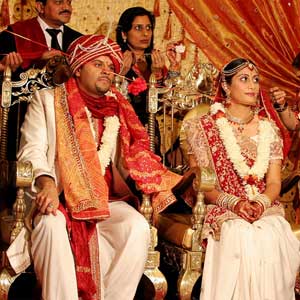
In the last century, an inter-caste marriage in India was a big deal. When my parents got married, my mother’s aunt is supposed to have commented sarcastically that my grandparents were quite revolutionary, because my father was a sub-sub-sub-sub-caste removed from my mother’s. Every least thing that could make the difference, did.
However, with increased urbanization and the erosion of international barriers, people of all castes and communities have come together for education, travel and work, and this has led to many “love” marriages. And as the world grows flatter, there has come a whole new acceptance of unions between people from different castes, family situations, and financial backgrounds.
It may not sound like a big deal when one is in New York, Los Angeles, or Atlanta, because one is used to a culture with varied races intermarrying in an open society like the one that exists in the United States. However, though India contains a variety of communities living practically on top of each other, they have remained almost water-tight over the years, without any intermingling. And personally, coming back to India from living in the U.S. for almost two decades, this phenomenon is somewhat eye-popping.
Of course, not all mixed marriages are accepted: horror stories of honor killings abound. Even in families that don’t resort to violent means to separate couples in love, there is a lot of pressure and manipulation brought to bear to make the parties concerned “see sense.” Many couples, whose families don’t approve, go to the Registrar’s to legalize their unions. But many families just want to see their sons and daughters happy, and they not only consent to the marriage but also undertake to conduct the wedding. And that is when the fun begins!
From time immemorial, Indian weddings have been the mainstay of religion, faith, and tradition, and people are loath to give it up. This might be the last chance they get to showcase their culture, and by God, they do it with fireworks. The most important rites of both parties are conducted and chants are said, but with priests taking time to explain what’s happening, something that is missing from an intra-cultural marriage, where everyone knows everything, or at least are familiar with everything thanks to repetition. Why, Esha Deol’s wedding to Bharat Takhtani was a “traditional” South Indian wedding that threw up so many contradictions that it ended up being a mix-and-match hodge-podge rather than a true-blue customary event.
The strange thing is that these traditions may not always be compatible, for quite often what is an absolute must in one culture is an equally absolute no-no in the other’s. For instance, conches are blown only at funerals in most South Indian cultures but are a part of Bengali weddings, while a red veil that is a bride’s crowning glory in a Kodava wedding resembles the attire of a Brahmin widow.
But come together, they do. While one wonders what made our ancestors adopt these peculiar customs, the end result of the manipulations and adjustments is somewhat like being served hamburgers with coconut chutney on the side.
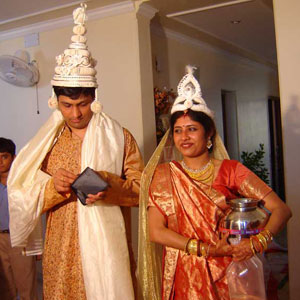
It is no longer peculiar to go to an Iyer friend’s daughter’s wedding and see the Dilliwala bridegroom arriving on a white horse to be received by madisaar-clad maamis. Or hear conches at a Gowda wedding. Wedding halls look like costume parties with saris and dresses, salwar-kurtas and sherwanis worn in just about every traditional Indian style. And of course, the wedding feasts resemble the menu of a multi-cuisine restaurant with dishes culled from kaara oota to thali to tandoori to Continental and Chinese.
Weddings used to be solemn occasions in which there was an underlying competition between families to see who would be more traditional. But these days, with mixed marriages especially, the wedding has become a spectacle or a pageant, where the families of the bride and groom are introduced to the best and most colorful features of the other’s cultural identity. Well, that is the intent, but what really goes on is a lot of funny compromises and a whole lot of gawking in a cut-and-paste type of event with odd sequences like a poorly edited movie.
I remember when being a guest at a wedding meant having to awaken reluctantly at unreasonable times of day and night, dress traditionally, and yawn through interminable sessions of the same old rites and rituals at the muhurats. These days, you eagerly charge up your camcorders, wear what you want that is jazzy enough, and dare not blink in case you miss something zany, like the bride’s North Indian father dressed in a dhoti over his pants at a Tamilian wedding, or a groom’s mother wearing a Kannada sari at a Kodava wedding. The homogenous nature of the cacophony heard at weddings has also changed, with the occasions sounding like an audio version of the rupee note’s list of official languages ... not to mention the dialects!
I have first-hand experience of a mixed marriage, because I had one. No, make that three ... weddings, that is. My husband and I met in the U.S., I a Madhwa Brahmin/ vegetarian by upbringing and choice, and my husband, a Kodava/dedicated omnivore, and married in 1993. The first was at the Registrar’s, the second, in a temple according to my family traditions, and the third was a typical Kodava wedding. However, the wedding is only the start of a marriage, which in the best of times is all about adjustments and compromises. This tends to be more of an experience in a mixed marriage.
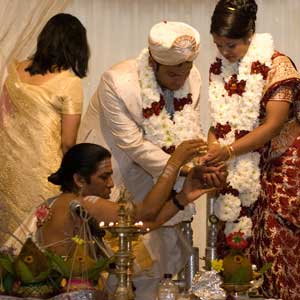
Take my own case. Previously my husband and I hadn’t had any experience with the other’s community, so it was all very new to us and our families. At the wedding, I found that my husband’s people were very warm and welcoming, and thought that all my worries about how I would adjust were unfounded. That is until I stepped into my in-laws’ house for the very first time, and they were frying fish for the feast. It was an initiation by smell, an orientation with an overdose of reality, an ordeal by endurance, which taught me a home truth, which is this.
Once the music of the shenai, nadaswara, and vaalaga have become mere echoes in memories or recordings on memory sticks, the newly-wedded couple settle down to real-life routines ... and realize an immutable fact. Marriages may be made in heaven and enjoyed in the privacy of the bedroom, but they are cemented in the kitchen. Yes, one may love rotis and aalu subzi once in a way, but if one grew up on rice and rasam or puliyogare, the rotis and subzi are going to pall after a while. Or, if one is used to murgh masalam and boti kabab but has to exist on onion sambar and beans koottu, sooner or later, something ... or someone ... has to give. This point is totally separate from the emotional aspect of marriage, and is definitely a factor in the everyday lives, especially those of veg and non-veg combos in a marriage, particularly in India, where being exclusively vegetarian or non-vegetarian is such a big deal.
Having already compromised on the most important decision, mixed couples take a while to work out the culinary conundrums. Vegetarian men turn omnivores without turning a hair, while carnivorous husbands go outside the home for their fix, at least during the honeymoon period. Women, on the other hand, have a harder time before the ground rules can be established. Some women turn non-veg themselves, some pin their noses with clothespins and wear gloves to cook meat for the husband but do not eat it themselves, and a few smart, lazy ones, like me, neither cook nor eat it.
However, women who stick to a vegetarian diet like me come to another decision point when children arrive on the scene. Kids with one carnivorous parent mostly become carnivores themselves, and proceed to put their mothers through emotional wringers. Upbringing and principles in the Vegetarian Woman make her reject the idea of her child becoming carnivorous, but the fact that children may derive more nutrition and pleasure out of a meaty meal causes her to falter. My first child was a pure vegetarian until she turned two and went to a day-care where they provided the food. She tried meatballs with her spaghetti, was hooked, and proceeded to sell me out. Once I found that she really liked it, I felt I couldn’t really forbid her to eat meat. After all, it was silly to make her stick to bean burritos, while she could see her father was tucking into a hamburger. The next rule to go was the one against cooking meat in the kitchen, but I compromised by setting aside a set of dishes exclusively for the meat stuff. That last bastion fell when one day, every pot and pan that I owned, save the meat-cookers, took up residence stubbornly in the dishwasher. What happened was inevitable and a no-brainer, and I succumbed quietly and abjectly.
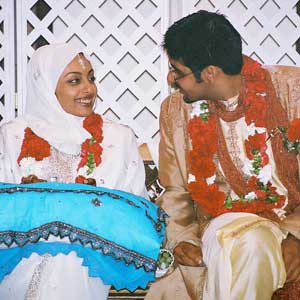
Language is another potential variable in a hybrid union, especially in a country with 22 official languages and a dialect a town. How they adjust to the spouse’s language depends on whether it is the husband or the wife you are talking about. Without exception, women want to be in the know. Therefore, a woman naturally picks up her husband’s mother tongue rapidly, basically since only then can she keep tabs on what the husband’s family is saying. Of course, she justifies this by saying that this is to enhance communication with her husband. And of course, it hardly takes any time for her to realize that the communication barrier at home is not so much due to the language, but due to the fact that her man has severely impaired listening skills (except when it comes to sports and car talk, when he just won’t shut up), probably due to his Y chromosome. That is when she switches to swearing in her own mother tongue, as swearing (and scolding) is done most efficiently and satisfactorily in one’s own language. Actually, I am a little handicapped in this because my husband knows Kannada (my mother tongue) very well. However, I compromise by swearing in Tamil which he doesn’t understand (I think).
It is common knowledge that the first year of a love marriage is harder than that of an arranged marriage. And just when the couple have settled their differences, and settled down, children come along to throw deeprooted convictions and prejudices into high relief. This means a period of adjustment to deal not just with the new little lovable tyrant who is now ruling the roost, but also on ways of bringing up said tyrant. Every book on parenting out there says that one set of rules only should be used to bring up baby so as not to confuse the infant, and both parents agree. But on whose culture it should be based? Remember that, in India, family is paramount, so both parents disagree, the in-laws pitch in with relish, and state-border wars are re-fought with fervor. Should the baby’s porridge be made of ragi or of jowar? Should his first solid meal be rice or chapati? Whose mother tongue should he speak at home?
Well, this period of adjustment ends about when the child shows its preference of a Lay’s potato chip and Cadbury’s milk chocolate over porridge and rice/chapati. Every child is a born manipulator with cute gummy smiles. Its built-in radar senses undercurrents of emotions far better than adults can, and uses them to get its own way. Therefore, from birth almost, the little one actually understands what both parents are fighting over, and trains both of them to accede to its wishes by playing one against the other.
On the plus side, the child learns languages, customs, and cultures very quickly and often acts as an interpreter to its parents and grandparents. Of course, this could be a mixed blessing, too. During a pre-India-vacation-training in traditions and customs that Indian-American children invariably get, I coyly asked my daughter what Indian word she would tell her ajji and thatha, my parents. With a toothy grin, she replied, “Pandi (pork)!” revealing her proud Kodava ancestry. I forbade her to speak anything but English and spent the entire time in India on tenterhooks, dreading the consequences if she blurted the word out to my traditional, Brahmin parents. And with the upcoming generations of mixed-community children, India, at least in urban areas, is slowly coming out of the “caste”-iron mould and becoming more accepting of other people and traditions. Hopefully, this trend results in a nation that is more broad-minded and unified at the grass-roots level, in its attitude towards its own citizens.
Meanwhile, I continue to look forward to invites for mixed unions, well knowing that more are surely on their way.
Freelance writer Lakshmi Palecanda spent two decades in the United States, most recently in Montana, before moving back to Mysore. She is still adjusting.
Enjoyed reading Khabar magazine? Subscribe to Khabar and get a full digital copy of this Indian-American community magazine.
blog comments powered by Disqus










